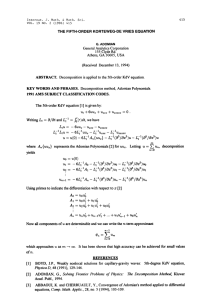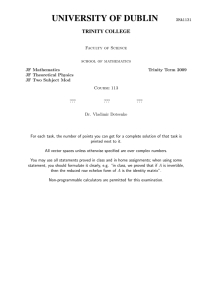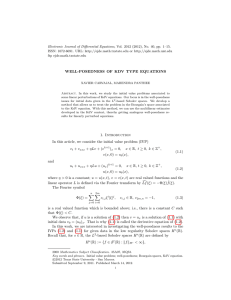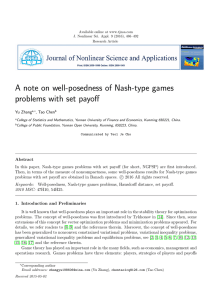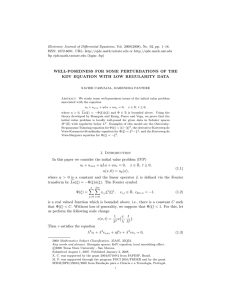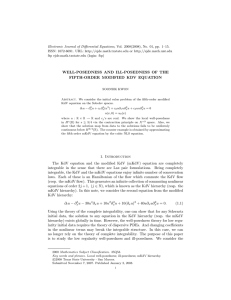Document 10747501
advertisement
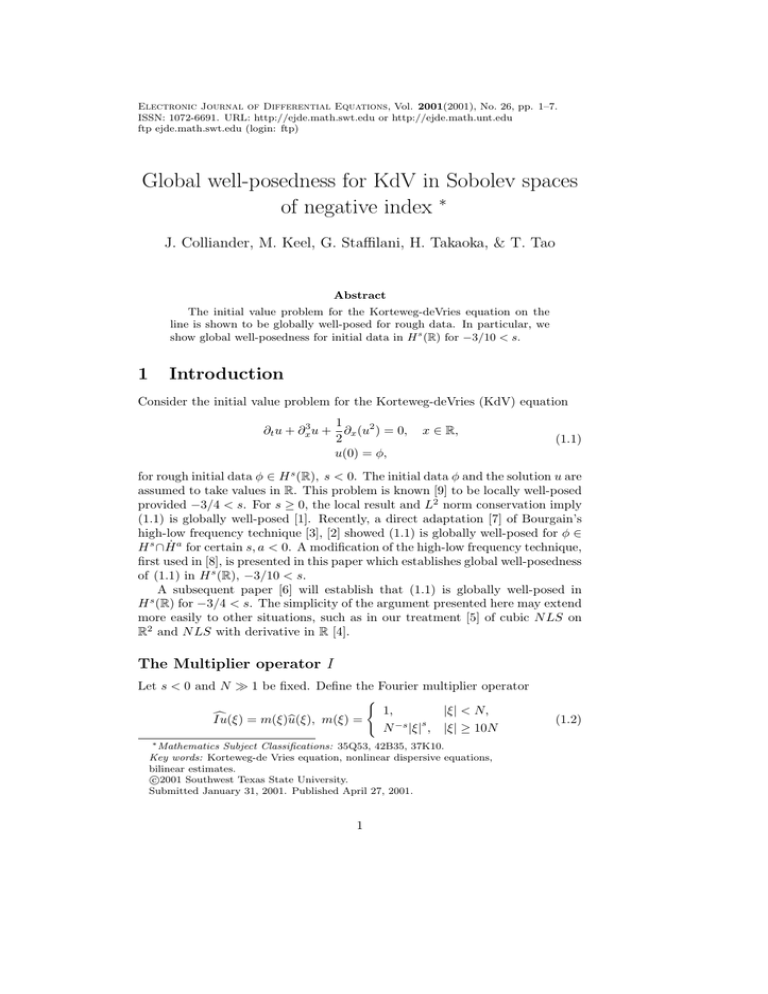
Electronic Journal of Differential Equations, Vol. 2001(2001), No. 26, pp. 1–7.
ISSN: 1072-6691. URL: http://ejde.math.swt.edu or http://ejde.math.unt.edu
ftp ejde.math.swt.edu (login: ftp)
Global well-posedness for KdV in Sobolev spaces
of negative index ∗
J. Colliander, M. Keel, G. Staffilani, H. Takaoka, & T. Tao
Abstract
The initial value problem for the Korteweg-deVries equation on the
line is shown to be globally well-posed for rough data. In particular, we
show global well-posedness for initial data in H s (R) for −3/10 < s.
1
Introduction
Consider the initial value problem for the Korteweg-deVries (KdV) equation
1
∂t u + ∂x3 u + ∂x (u2 ) = 0,
2
u(0) = φ,
x ∈ R,
(1.1)
for rough initial data φ ∈ H s (R), s < 0. The initial data φ and the solution u are
assumed to take values in R. This problem is known [9] to be locally well-posed
provided −3/4 < s. For s ≥ 0, the local result and L2 norm conservation imply
(1.1) is globally well-posed [1]. Recently, a direct adaptation [7] of Bourgain’s
high-low frequency technique [3], [2] showed (1.1) is globally well-posed for φ ∈
H s ∩ Ḣ a for certain s, a < 0. A modification of the high-low frequency technique,
first used in [8], is presented in this paper which establishes global well-posedness
of (1.1) in H s (R), −3/10 < s.
A subsequent paper [6] will establish that (1.1) is globally well-posed in
H s (R) for −3/4 < s. The simplicity of the argument presented here may extend
more easily to other situations, such as in our treatment [5] of cubic N LS on
R2 and N LS with derivative in R [4].
The Multiplier operator I
Let s < 0 and N 1 be fixed. Define the Fourier multiplier operator
(
1,
|ξ| < N,
c
Iu(ξ)
= m(ξ)b
u(ξ), m(ξ) =
s
−s
N |ξ| , |ξ| ≥ 10N
∗ Mathematics Subject Classifications: 35Q53, 42B35, 37K10.
Key words: Korteweg-de Vries equation, nonlinear dispersive equations,
bilinear estimates.
c
2001
Southwest Texas State University.
Submitted January 31, 2001. Published April 27, 2001.
1
(1.2)
2
Global well-posedness for KdV
EJDE–2001/26
with m smooth and monotone. The operator I (barely) maps H s (R) 7−→ L2 (R).
Observe that on low frequencies {ξ : |ξ| < N }, I is the identity operator. Note
also that I commutes with differential operators. The operator I −1 is the Fourier
1
multiplier operator with multiplier m(ξ)
.
An almost L2 conservation property of (1.1)
Let φ ∈ H s (R), −3/4 < s < 0 in (1.1). There is a δ = δ(kφkH s ) > 0 such that
(1.1) is well-posed for t ∈ [0, δ]. We observe using the Fundamental Theorem of
Calculus, the equation, and integration by parts that
Z δ
d
2
2
kIu(δ)kL2 = kIu(0)kL2 +
(Iu(τ ), Iu(τ ))dτ,
dτ
0
Z δ
2
= kIu(0)kL2 + 2
(I u̇(τ ), Iu(τ ))dτ,
0
2
= kIu(0)kL2 + 2
=
Finally, we add 0 =
2
kIu(δ)kL2
2
kIu(0)kL2
RδR
+
δ
Z
Z
0
δ
1
(I(−uxxx − ∂x [u2 ])(τ ), Iu(τ ))dτ
2
(I(−∂x [u2 ]), Iu)dτ.
0
2
∂x (I(u) )I(u)dτ to observe
Z δZ
n
o
2
2
= kIu(0)kL2 +
∂x (I(u)) − I(u2 ) Iu dxdτ.
0
(1.3)
0
This last step enables us to take advantage of some internal cancellation. We
apply Cauchy-Schwarz as in [10] and bound the integral above by
2
kIukX δ .
(1.4)
∂x {(I(u)) − I(u2 )} δ
X
0,− 1 −
2
0, 1 +
2
δ
The space Xs,b
of functions of space-time is defined via the Fourier restriction
norm kukX δ = inf{kwkXs,b := k(1 + |k|)s (1 + |τ − k 3 |)b w(k,
b τ )kL2 : w =
s,b
k,τ
u for t ∈ [0, δ]}.
Remark 1 An effort to find a term providing more cancellation than
RδR
2
∂x (I(u) )I(u)dτ used above led to the general procedure described in [6].
0
Proposition 1 (A variant of local well-posedness) The initial value problem (1.1) is locally well-posed in the Banach space
I −1 L2 = {φ ∈ H s with norm kIφkL2 } with existence lifetime δ satisfying
−α
δ & kIφkL2 , for some α > 0,
(1.5)
and moreover
kIukX δ
0, 1 +
2
≤ CkIφkL2 .
(1.6)
EJDE–2001/26
J. Colliander et al.
3
This proposition is not difficult to prove using the argument in [9]. Using
Duhamel’s formula and Xs,b space properties reduces matters to proving the
bilinear estimate
k∂x I(uv)kX
0,− 1 +
2
≤ CkIukX
0, 1 +
2
kIvkX
(1.7)
0, 1 +
2
to obtain the contraction. The space-time norm bound is then implied by the
contraction estimate. The estimate (1.7) follows from the next proposition and
the bilinear estimate of Kenig, Ponce and Vega [9].
Proposition 2 (Extra smoothing) The bilinear estimate
3
k∂x {I(u)I(v) − I(uv)}kX δ
0,− 1 −
2
≤ CN − 4 + kIukX δ
0, 1 +
2
kIvkX δ
0, 1 +
2
.
(1.8)
holds.
Recall the bilinear estimate k∂x (uv)kX
0,− 1 +
2
≤ CkukX
0, 1 +
2
kvkX
0, 1 +
2
from [9].
Proposition 2 reveals a smoothing beyond the recovery of the first derivative
for the particular quadratic expression encountered above in (1.3). We prove
Proposition 2 in the next section.
The required pieces are now in place for us to give the proof of global wellposedness of (1.1) in H s (R), −3/10 < s. Global well-posedness of (1.1) will
follow if we show well-posedness on [0, T ] for arbitrary T > 0. We re-normalize
2
things a bit via scaling. If u solves (1.1) then uλ (x, t) = ( λ1 ) u( λx , λt3 ) solves
2
(1.1) with initial data φλ (x, t) = ( λ1 ) φ( λx ). Note that u exists on [0, T ] if and
only if uλ exists on [0, λ3 T ]. A calculation shows that
3
kIφλ kL2 ≤ Cλ− 2 −s N −s kφkH s .
(1.9)
Here N = N (T ) will be selected later but we choose λ = λ(N ) right now by
requiring
2s
3
Cλ− 2 −s N −s kφkH s ∼ 1 =⇒ λ ∼ N − 3+2s .
(1.10)
We now drop the λ subscript on φ by assuming that
kIφkL2 = 0 1
(1.11)
and our goal is to construct the solution of (1.1) on the time interval [0, λ3 T ].
The local well-posedness result of Proposition 1 shows we can construct the
solution for t ∈ [0, 1] if we choose 0 small enough. The almost L2 conservation
3
2
2
3
property shows kIu(1)k2 ≤ kIu(0)k2 + N − 4 + kIukX 1 . Using (1.6) and (1.11)
0,
gives
2
2
+
3
kIu(1)k2 ≤ 20 + N − 4 + .
3
We can iterate this process N 4 − times before doubling kIu(t)kL2 . Therefore,
3
we advance the solution by taking N 4 − time steps of size O(1). We now restrict
s by demanding that
−6s
3
N 4 − & λ3 T = N 3+2s T
(1.12)
is ensured for large enough N , so s > −3/10.
4
2
Global well-posedness for KdV
EJDE–2001/26
Proof of the bilinear smoothing estimate
This section establishes Proposition 2. We distinguish the very low frequencies {ξ : |ξ| . 1}, the low frequencies {ξ : 1 . |ξ| . 12 N } and the high
frequencies {ξ : 12 N . |ξ|}. Decompose the factor u in the bilinear estimate
by writing u = uvl + ul + uh with ubl supported on the low frequencies and
similarly for the very low and high frequency pieces. We decompose v the same
way. Since I is the identity operator on the low and very low frequencies, we can
assume one of the factors u, v in the estimate to be shown has its Fourier transform supported in the high frequencies. Symmetry allows us to assume u = uh
and we need to consider the three possible interactions of uh with vvl , vl and
vh . Finally, since we are considering (weighted) L2 norms, we can replace u
b and
vb by |b
u| and |b
v |. Assume therefore that u
b, vb ≥ 0.
Very low/high interaction
An explicit calculation shows that
F (∂x {I(uh vvl ) − I(uh )vvl }) (ξ) =
Z
ξ=ξ1 +ξ2
iξ[m(ξ) − m(ξ1 )]c
uh (ξ1 )vc
vl (ξ2 ),
(2.1)
where F denotes the Fourier transform. The mean value theorem gives
|m(ξ) − m(ξ1 )| ≤ |m0 (ξ˜1 )||ξ2 |,
which may be interpolated with the trivial estimate to give
−θ
s
|m(ξ) − m(ξ1 )| ≤ CN −s |ξ1 | |ξ1 |
θ
|ξ2 |
(2.2)
for 0 ≤ θ ≤ 1. Recall that m was defined to be smooth and monotone in (1.2).
θ
Therefore, upon defining F(∇θ f )(ξ) = |ξ| fb(ξ), we can write
|F(∂x {I(uh vvl ) − I(uh )vvl })(ξ)| ≤ |F(∂x (∇−θ I(uh )(∇θ vvl ))(ξ)|.
We now estimate the left side of the bilinear estimate in this interaction by
∂x (∇−θ I(uh ))(∇θ vvl )
(2.3)
X 1
0,
2
+
and by the bilinear estimate of Kenig, Ponce and Vega
≤ C ∇−θ I(uh )X 1 ∇θ vvl X 1 .
0,
2
+
0,
2
The frequency support of vvl shows that ∇θ vvl X
0, 1 +
2
ments thought shows
−θ
∇ I(uh )
X
0, 1 +
2
≤ N −θ kI(uh )kX
(2.4)
+
. kvvl kX
0, 1 +
2
0, 1 +
2
. A mo-
(2.5)
and the claim of the Proposition follows for the (very low)(high) interaction by
choosing θ > 3/4.
EJDE–2001/26
J. Colliander et al.
5
Low/high interaction
The preceding calculations reduce matters to controlling
∂x ∇−θ I(uh )∇θ vl X 1
0,
2
(2.6)
+
and we know that u
ch and vbl are supported outside the very low frequencies.
Lemma 1 Assume u
b and vb are supported outside {|ξ| < 1}. Then
≤ CkukX
k∂x (uv)kX
−γ1 , 1 +
2
α,− 1 +
2
kvkX
(2.7)
−γ2 , 1 +
2
provided
3
,
4
1
, i = 1, 2.
2
α − (γ1 + γ2 ) <
α − γi
<
We will apply the lemma momentarily with α = 0, γ1 = γ2 = −3/8+.
The proof of the lemma is contained in the proof of Theorem 2 in [7]. In
particular, the support properties on u
b, vb reduce matters to considering Cases
A.3, A.4, A.6, B.3, B.4, B.5 and B.6 in [7]. The restriction α − (γ1 + γ2 ) < 3/4
arises in Case A.4.c.ii of [7] which is the region containing the counterexample
of [9]. Case B.4.b of [7] requires the other condition α − γi < 12 .
The lemma applied to (2.6) gives
≤ C ∇−θ I(uh )X 3 1 ∇θ vl X 3 1 .
−
8
+,
2
−
+
8
+,
2
+
Setting θ = 83 − leaves
3
C ∇− 4 + I(uh )
X0, 1 +
3
kvl kX
2
0, 1 +
2
≤ CN − 4 + kI(uh )kX
0, 1 +
2
kvl kX
0, 1 +
2
which was to be shown.
High/high interaction
In this region of the interaction, we do not take advantage of any cancellation
and estimate the difference with the triangle inequality
k∂x {I(uh )I(vh )}kX
0,− 1 +
2
+ k∂x {I(uh vh )}kX
0,− 1 +
2
.
For the first contribution we use the lemma to get
kI(uh )kX
− 3 +, 1 +
8
2
kI(vh )kX
− 3 +, 1 +
8
2
3
≤ N − 4 + kI(uh )kX
0, 1 +
2
kI(vh )kX
0, 1 +
2
.
(2.8)
6
Global well-posedness for KdV
EJDE–2001/26
The second contribution is bounded by throwing away I and applying the
lemma,
k∂x {uh vh }kX
0,− 1 +
2
≤
kuh kX
− 3 +, 1 +
8
2
≤ N
− 38 +s+
≤ N
− 34 +
kuh kX
kuh kX
− 3 +, 1 +
8
2
− 38 +s+
s, 1 +
2
kuh kX
0, 1 +
2
N
kvh kX
s, 1 +
2
kvh kX
0, 1 +
2
.
Acknowledgments J.E.C. is supported in part by an N.S.F. Postdoctoral
Research Fellowship. M.K. is supported in part by N.S.F. Grant DMS 9801558.
G.S. is supported in part by N.S.F. Grant DMS 9800879 and by a Terman
Award. T.T. is a Clay Prize Fellow and is supported in part by grants from the
Packard and Sloan Foundations.
References
[1] J. Bourgain. Fourier transform restriction phenomena for certain lattice
subsets and applications to nonlinear evolution equations I,II. Geom. Funct.
Anal., 3:107–156, 209–262, 1993.
[2] J. Bourgain. Refinements of Strichartz’ inequality and applications to 2DNLS with critical nonlinearity. International Mathematical Research Notices, 5:253–283, 1998.
[3] J. Bourgain. Global solutions of nonlinear Schrödinger equations. American
Mathematical Society, Providence, RI, 1999.
[4] J. Colliander, M. Keel, G. Staffilani, H. Takaoka, and T. Tao. Global wellposedness for Schrödinger equations with derivative. Submitted to SIAM
J. Math. Anal., 2001.
[5] J. Colliander, M. Keel, G. Staffilani, H. Takaoka, and T. Tao. Global wellposedness of 2d NLS. (in preparation), 2001.
[6] J. Colliander, M. Keel, G. Staffilani, H. Takaoka, and T. Tao. Global wellposedness of KdV and modified KdV on R and T. (preprint), 2001.
[7] J. E. Colliander, G. Staffilani, and H. Takaoka. Global wellposedness of
KdV below L2 . Mathematical Research Letters, 6(5,6):755–778, 1999.
[8] M. Keel and T. Tao. Local and Global Well-Posedness of Wave Maps
on R1+1 for Rough Data. International Mathematical Research Notices,
21:1117–1156, 1998.
[9] C. Kenig, G. Ponce, and L. Vega. A bilinear estimate with applications to
the KdV equation. J. Amer. Math. Soc., 9:573–603, 1996.
EJDE–2001/26
J. Colliander et al.
7
[10] G. Staffilani. On the growth of high Sobolev norms of solutions for KdV
and Schrödinger equations. Duke Math. J., 86(1):109–142, 1997.
James Colliander
Department of Mathematics
University of California
Berkeley, California, 94720-3840 USA
e-mail: colliand@math.berkeley.edu
Markus Keel
Department of Mathematics
Caltech
Pasadena, California, 91125, USA
e-mail: keel@cco.caltech.edu
Gigliola Staffilani
Department of Mathematics
Stanford University
Stanford, California, 94305, USA
e-mail: gigliola@math.stanford.edu
Hideo Takaoka
Division of Mathematics
Graduate School of Science
Hokkaido University
Sapporo, 060-0810, Japan.
e-mail: takaoka@math.sci.hokudai.ac.jp
Terence Tao
Department of Mathematics
University of California,
Los Angeles, California, 90095-1596, USA
e-mail:tao@math.ucla.edu

